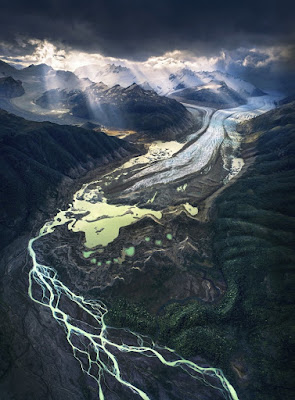Following recent visits to Ceibwr, I think I'm getting the story sorted out at long last. It's not easy, since there is no single location where the full sequence of sediments can be seen. There are more than a dozen exposures in and around the bay, so extrapolations are necessary.......
These are the key locations:
SN107457 -- roadside exposures of cemented glaciofluvial gravels
SN107457 -- gully with potholes (channel 3) near coast
SN108457 -- largest exposure of cemented gravels etc -- near tip of spur
SN110456 -- plug of Irish Sea Till and other deposits in mouth of valley (Channel 1)
SN109456 -- intake for Channel 2 (hump)
SN108456 -- meltwater erosion traces on rock wall of Channel 2
SN109456 -- hummock of fresh glaciofluvial gravels filling entrance to Channel 2
SN110455 -- riverside exposure -- cemented gravels beneath Irish Sea Till
Herewith a photo gallery with annotations in roughly the order of the list above. We concentrate here on the features in and around the Ceibwr Gully -- I'll deal with the other exposures in a later post.
Roadside exposure. Approx 1m of cemented iron-stained glaciofluvial gravels with horizontal bedding, resting on vertical strata of Ordovician shales. A classic unconformity........
Roadside -- cemented gravels. Here they appear to be plastered against the side of the shale bedrock ourcrop. The location is about 10m above the floor of Channel 2, which we see at the right edge of the photo. It's most reasonable to propose that the gravels were emplaced by water flowing along an ice edge, at a time when the channel was filled by wasting ice.
A second exposure of horizontally bedded gravels, a little way uphill. These are also solidly cemented, but the exposed surface is covered with mosses and lichens.
The small gully (Channel 3) with potholes, on the western flank of the exit of Channel 2 where it reaches the coast. The potholes contain many large submerged erratics, including some that are far-travelled, of igneous origin.
Rock surface on the flank of the gully, showing classic pothole erosional features and surface staining by iron and manganese oxide.
This might just be the oldest Pleistocene deposit ever recorded in Wales. It's a cemented slope breccia, high on the western flank of Channel 2, with the gully (Channel 3) directly below. The gully may or may not be younger than the deposit -- more investigations are needed. There is no stratification here -- this is a typical rockfall or slope collapse deposit, which probably has nothing to do with frost processes or periglacial conditions. The cemented till and cemented gravels lie ABOVE this deposit.

In the same exposure, above the gully, we see TWO tills of vastly different ages. The lower till is cemented, and is most reasonably interpreted as of Anglian age. Above that we see stratified glaciofluvial gravels, also cemented -- with several different facies. Above that, uncemented grey-blue clay-rich till with many of the characteristics of Irish Sea Till -- probably of Devensian age. This is a hugely significant photograph -- I need to visit the site again in the company of other Pleistocene specialists.......
Remnants of cemented slope breccia with erratics (ancient till?), at the water line within one of the potholes. The gully might have been cut -- or at least enlarged -- in the Anglian glaciation, before the deposition of the concreted till.
Close-up of the concreted till (Anglian?) on the slope above the gully. It incorporates broken slabs of local bedrock, a wide range of erratics (including igneous rock types), and cobbles and pebbles of many different sizes. Some of these rounded stones have been glaciofluvially transported, and some may even have been derived from raised beaches that are now destroyed. The deposit is matrix-supported. This might be a flow-till.
Above the glaciofluvial gravels, near the end of the trowel handle, there is a layer of clay-rich colluvium up to 20 cms thick, stained orange and red by pedological processes, and above that a "churned" layer of slope breccia.
The churned slope breccia deposit, made of shale fragments derived from a rock outcrop immediately upslope. This deposit is uncemented.
The head of the gully is plugged with c 2m of cemented red-stained till and glaciofluvial gravels (seen here in the lower half of the photo) and grey-blue uncemented Irish Sea till with abundant erratic boulders above. I'm pretty certain that these deposits represent two distinct glacial episodes.
Above the double till layers we see c 50 cm of sandy and silty colluvium / sandy loam which is elsewhere called Sandloess. There are occasional erratics within it, probably redeposited from outcrops upslope. This must have accumulated during the Holocene / post-glacial period. The modern soil horizon is seen at the top of the section.
On piecing things together, the full Pleistocene stratigraphy here seems to be as follows:
Modern soil -- c 20 cms. Uncemented
Sandloess and colluvium -- c 50 cms. Uncemented. Holocene?
Clay-rich Irish Sea Till -- up to 2 m thick. Uncemented. Devensian?
Brecciated slope deposits -- up to 50 cms thick. Uncemented
Clay-rich colluvium -- c 20 cms thick. Uncemented but stained / gleyed. Ipswichian interglacial?
Glaciofluvial gravels -- c 1.5m thick. Stained and cemented. Anglian?
Stony till -- up to 1m thick. Stained and cemented. Anglian?
Brecciated slope deposits -- up to 1 m thick
I need to consult with other geomorphologists on all of this, but I'm pretty sure that this set of deposits ties in rather neatly with the old till / new till situation described from Lydstep:
https://brian-mountainman.blogspot.com/2018/05/lydstep-ancient-till-site-confirmed.html
The cementation process is crucial to the interpretation of these deposits -- are the cemented deposits all very old, and are all of the uncemented deposits relatively young?
https://brian-mountainman.blogspot.com/2018/11/on-significance-of-cementation.html
Next, I must go back to the Witches Cauldron and check out the extremely complicated cemented deposits there. More clues will undoubtedly emerge.......
I'll do another post shortly on the other exposures at Ceibwr, which broadly confirm the sequence described above.






















































